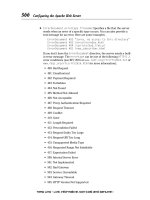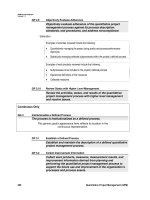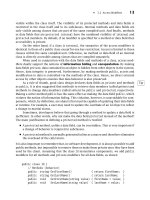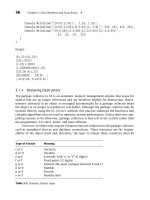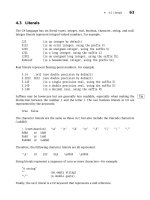TCP/IP Sockets in C# Practical Guide for Programmers phần 9 potx
Bạn đang xem bản rút gọn của tài liệu. Xem và tải ngay bản đầy đủ của tài liệu tại đây (121.26 KB, 19 trang )
140 Chapter 4: Beyond the Basics
■
TranscodeServer
TranscodeClient
<unencoded bytes>
<unencoded bytes>
<encoded bytes>
Shutdown
<encoded bytes>
Closed
Figure 4.3: Transcode Server protocol termination.
As we mentioned earlier, some advanced functionality is available only in the Socket
class and not the higher level socket classes like TcpClient. The Shutdown() method of
the Socket class is an example of a feature that is not directly accessible in the TcpClient
class. However, the TcpClient class does give us access to its underlying Socket instance
through its protected Socket property. Since the property is protected, it can only be
accessed by extending the original TcpClient class. We have decided to illustrate this
technique here by extending the TcpClient class to access the Socket method Shutdown().
We have created the TcpClientShutdown class in order to do this.
TcpClientShutdown.cs
0 using System; // For String
1 using System.Net; // For IPEndPoint, EndPoint
2 using System.Net.Sockets; // For TcpClient, SocketShutdown
3
4 class TcpClientShutdown : TcpClient {
5
6 public TcpClientShutdown():base() {}
7 public TcpClientShutdown(IPEndPoint localEP):base(localEP) {}
8 public TcpClientShutdown(String server, int port):base(server, port) {}
9
10 public void Shutdown(SocketShutdown ss) {
11 // Invoke the Shutdown method on the underlying socket
12 this.Client.Shutdown(ss);
13 }
■
4.6 Closing Connections 141
14 public EndPoint GetRemoteEndPoint() {
15 // Return the RemoteEndPoint from the underlying socket
16 return this.Client.RemoteEndPoint;
17 }
18 }
TcpClientShutdown.cs
1. Extend the TcpClient class: line 4
2. Extend the constructors: lines 6–8
Extending the constructors with the base keyword is required. Additional constructor
logic can also be added but is not required.
3. Shutdown(): lines 10–13
The new user-defined Shutdown() method invokes the Socket method of the same
name by using the Client property.
4. GetRemoteEndPoint(): lines 14–17
The new user-defined GetRemoteEndPoint() method retrieves the RemoteEndPoint
property from the underlying Socket by using the Client property.
TranscodeClient.cs
0 using System; // For String, Int32, Console, ArgumentException
1 using System.IO; // For FileStream
2 using System.Net.Sockets; // For NetworkStream, TcpClient
3
4 public class TranscodeClient {
5
6 private const int BUFSIZE = 256; // Size of read buffer
7
8 private static NetworkStream netStream;
9 private static FileStream fileIn;
10 private static TcpClientShutdown client;
11
12 public static void Main(string[] args) {
13
14 if (args.Length != 3) // Test for correct # of args
15 throw new ArgumentException("Parameter(s): <Server> <Port> <File>");
16
17 String server = args[0]; // Server name or IP address
18 int port = Int32.Parse(args[1]); // Server port
19 String filename = args[2]; // File to read data from
142 Chapter 4: Beyond the Basics
■
20
21 // Open input and output file (named <input>.ut8)
22 fileIn = new FileStream(filename, FileMode.Open, FileAccess.Read);
23 FileStream fileOut = new FileStream(filename + ".ut8", FileMode.Create);
24
25 // Create TcpClient connected to server on specified port
26 client = new TcpClientShutdown();
27 client.Connect(server, port);
28
29 // Send nonencoded byte stream to server
30 netStream = client.GetStream();
31 sendBytes();
32
33 // Receive encoded byte stream from server
34 int bytesRead; // Number of bytes read
35 byte[] buffer = new byte[BUFSIZE]; // Byte buffer
36 while ((bytesRead = netStream.Read(buffer, 0, buffer.Length)) > 0) {
37 fileOut.Write(buffer, 0, bytesRead);
38 Console.Write("R"); // Reading progress indicator
39 }
40
41 Console.WriteLine(); // End progress indicator line
42
43 netStream.Close(); // Close the stream
44 client.Close(); // Close the socket
45 fileIn.Close(); // Close input file
46 fileOut.Close(); // Close output file
47 }
48
49 private static void sendBytes() {
50 int bytesRead; // Number of bytes read
51 BufferedStream fileInBuf = new BufferedStream(fileIn);
52 byte[] buffer = new byte[BUFSIZE]; // Byte buffer
53 while ((bytesRead = fileInBuf.Read(buffer, 0, buffer.Length)) > 0) {
54 netStream.Write(buffer, 0, bytesRead);
55 Console.Write("W"); // Writing progress indicator
56 }
57 client.Shutdown(SocketShutdown.Send); // Done sending
58 }
59 }
TranscodeClient.cs
■
4.6 Closing Connections 143
1. Application setup and parameter parsing: lines 14–19
2. Create socket and open files: lines 21–30
Using the TcpClientShutdown class to allow us access to the underlying Socket
methods and properties.
3. Invoke sendBytes() to transmit bytes: line 31
4. Receive the UTF-8 data stream: lines 33–39
The while loop receives the UTF-8 data stream and writes the bytes to the output file
until an end-of-stream is signaled by a 0 from Read().
5. Close socket and streams: lines 43–46
6. sendBytes(): lines 49–58
Given a socket connected to a Transcode server and the file input stream, read all of
the Unicode bytes from the file and write them to the socket network stream.
■
Set up input file buffered stream: lines 50–52
■
Send Unicode bytes to Transcode server: lines 53–56
The while loop reads from the input stream (in this case from a buffered file stream)
and repeats the bytes to the socket network stream until end-of-file, indicated by
0 from Read(). Each write is indicated by a “W” printed to the console.
■
Shut down the socket output stream: line 57
After reading and sending all of the bytes from the input file, shut down the output
stream, notifying the server that the client is finished sending. The close will cause
a 0 return from Read() on the server.
To implement the Transcode server, we simply write a server-side conversion pro-
tocol using the static UTF-8 Encoding class. The server receives the Unicode bytes from
the client, converts them to UTF-8, and writes them back to the client.
TranscodeServer.cs
0 using System; // For String, Int32, Console
1 using System.Text; // For Encoding
2 using System.Net; // For IPAddress
3 using System.Net.Sockets; // For TcpListener, TcpClient, NetworkStream
4
5 public class TranscodeServer {
6
7 public static readonly int BUFSIZE = 1024; // Size of read buffer
8
9 public static void Main(string[] args) {
10
11 if (args.Length != 1) // Test for correct # of args
12 throw new ArgumentException("Parameter(s): <Port>");
144 Chapter 4: Beyond the Basics
■
13
14 int servPort = Int32.Parse(args[0]); // Server port
15
16 // Create a TcpListener to accept client connection requests
17 TcpListener listener = new TcpListener(IPAddress.Any, servPort);
18 listener.Start();
19
20 byte[] buffer = new byte[BUFSIZE]; // Allocate read/write buffer
21 int bytesRead; // Number of bytes read
22 for (;;) { // Run forever, accepting and servicing connections
23 // Wait for client to connect, then create a new TcpClient
24 TcpClient client = listener.AcceptTcpClient();
25
26 Console.WriteLine("\nHandling client ");
27
28 // Get the input and output streams from socket
29 NetworkStream netStream = client.GetStream();
30
31 int totalBytesRead = 0;
32 int totalBytesWritten = 0;
33
34 Decoder uniDecoder = Encoding.Unicode.GetDecoder();
35 Char[] chars = null;
36
37 // Receive until client closes connection, indicated by 0 return
38 while ((bytesRead = netStream.Read(buffer, 0, buffer.Length)) > 0) {
39 totalBytesRead += bytesRead;
40
41 // Convert the incoming bytes to Unicode char array
42 int charCount = uniDecoder.GetCharCount(buffer, 0, bytesRead);
43 chars = new Char[charCount];
44 int charsDecodedCount = uniDecoder.GetChars(buffer, 0, bytesRead, chars, 0);
45
46 // Convert the Unicode char array to UTF8 bytes
47 int byteCount = Encoding.UTF8.GetByteCount(chars, 0, charsDecodedCount);
48 byte[] outputBuffer = new byte[byteCount];
49 Encoding.UTF8.GetBytes(chars, 0, charsDecodedCount, outputBuffer, 0);
50
51 // Send UTF8 bytes back to client
52 netStream.Write(outputBuffer, 0, outputBuffer.Length);
53 totalBytesWritten += outputBuffer.Length;
54 }
55
■
4.7 Wrapping Up 145
56 Console.WriteLine("Total bytes read: {0}", totalBytesRead);
57 Console.WriteLine("Total bytes written: {0}", totalBytesWritten);
58 Console.WriteLine("Closing client connection ");
59
60 netStream.Close(); // Close the stream
61 client.Close(); // Close the socket
62 }
63 /* NOT REACHED */
64 }
65 }
TranscodeServer.cs
1. Parameter parsing and socket setup: lines 11–18
2. Accept a connection and get the stream: lines 24–29
3. Initialize byte counters and encodings: lines 31–35
4. Loop until end of stream, performing: lines 37–54
■
Read network stream into buffer: line 38
Read up to the maximum buffer size bytes until 0 is returned indicating the
Shutdown(SocketShutdown.Send) call was invoked by the client.
■
Increment total bytes read: line 39
■
Convert Unicode to UTF-8: lines 41–48
Note that we are receiving data in the multibyte format (Unicode) over a medium
that does not preserve message boundaries (TCP). This means that it is possible
that a given read contains an odd number of bytes, creating an incomplete Unicode
character at the end. Luckily, .NET provides a class for just such a situation. The
Decoder class keeps state from one call to the next. Therefore if a call to GetChars()
ends with an incomplete character, the bytes for that incomplete character are
stored and added to the beginning of the next input to GetChars(). This allows us
to process the stream data correctly regardless of where the message boundaries
fall.
■
Write the UTF-8 bytes out of the network stream: line 52
■
Increment total bytes written: line 53
5. Output results: lines 56–58
6. Close stream and socket: lines 60–61
4.7 Wrapping Up
We have discussed some of the ways .NET provides access to advanced features of the
sockets API, and how built-in features such as threads can be used with socket programs.
146 Chapter 4: Beyond the Basics
■
In addition to these facilities, .NET provides several mechanisms that operate on top of
TCP or UDP and attempt to hide the complexity of protocol development. For example,
Remoting allows .NET objects on different hosts to invoke one another’s methods as if
the objects all reside locally. Many other standard .NET library mechanisms exist, pro-
viding an amazing range of services. These mechanisms are beyond the scope of this
book; however, we encourage you to look at the the Microsoft Developer Network site at
www.msdn.microsoft.com for descriptions and code examples for some of these libraries.
4.8 Exercises
1. State precisely the conditions under which an iterative server is preferable to a
multiprocessing server.
2. Would you ever need to implement a timeout in a client or server that uses TCP?
3. How can you determine the minimum and maximum allowable sizes for a socket’s
send and receive buffers? Determine the minimums for your system.
4. Write an iterative dispatcher using the dispatching framework from this chapter.
5. Write the server side of a random-number server using the protocol factory frame-
work from this chapter. The client will connect and send the upper bound, B, on the
random number to the server. The server should return a random number between
1 and B, inclusive. All numbers should be specified in binary format as 4-byte,
two’s-complement, big-endian integers.
6. Modify TcpEchoClient.cs so that it closes its output side of the connection before
attempting to receive any echoed data.
7. Modify TcpEchoServerAsync.cs so that it polls for the accept to be completed after
each sleep in the doOtherStuff() method (instead of waiting until each method call
completes).
8. Modify some of the existing programs to implement asynchronous DNS lookups and
asynchronous Connect().
chapter 5
Under the Hood
Some of the subtleties of network programming are difficult to grasp without some
understanding of the data structures associated with the socket implementation and cer-
tain details of how the underlying protocols work. This is especially true of TCP sockets
(i.e., instances of TcpClient, TcpListener, or a TCP instance of Socket). This chapter
describes some of what goes on in the runtime implementation when you create and use
an instance of Socket or one of the higher level TCP classes that utilize sockets. Unless
specifically stated otherwise, references to the behavior of the Socket class in this chapter
also apply to TcpClient and TcpListener classes, which create Socket instances “under the
hood.” (The initial discussion and Section 5.2 apply as well to UdpClient). However, most
of this chapter focuses on TCP sockets, that is, a TCP instance of Socket (whether used
directly or indirectly via a higher level class). Please note that this description covers only
the normal sequence of events and glosses over many details. Nevertheless, we believe
that even this basic level of understanding is helpful. Readers who want the full story are
referred to the TCP specification [12] or to one of the more comprehensive treatises on the
subject [3, 20, 22].
Figure 5.1 is a simplified view of some of the information associated with a Socket
instance. The classes are supported by an underlying implementation that is provided by
the CLR and/or the platform on which it is running (i.e., the “socket layer” of the Windows
operating system). Operations on the C# objects are translated into manipulations of this
underlying abstraction. In this chapter, “Socket” refers generically to one of the classes
in Figure 5.1, while “socket” refers to the underlying abstraction, whether it is provided
by an underlying OS or the CLR implementation itself (e.g., in an embedded system). It is
important to note that other (possibly non-C#/.NET) programs running on the same host
may be using the network via the underlying socket abstraction and thus competing with
C# Socket instances for resources such as ports.
147
148 Chapter 5: Under the Hood
■
Closed
Local port
Local IP
Remote port
Remote IP
Underlying socket structure
NetworkStream / byte array
NetworkStream / byte array
SendQ
RecvQ
To network
Socket, TcpClient,
TcpListener, or
UdpClient instance
Application program
Underlying implementation
Figure 5.1: Data structures associated with a socket.
■
5.1 Buffering and TCP 149
By “socket structure” here we mean the collection of data structures in the underlying
implementation (of both the CLR and TCP/IP, but primarily the latter) that contain the
information associated with a particular Socket instance. For example, the socket structure
contains, among other information:
■
The local and remote Internet addresses and port numbers associated with the socket.
The local Internet address (labeled “Local IP” in Figure 5.1) is one of those assigned
to the local host; the local port is set at Socket creation time. The remote address and
port identify the remote socket, if any, to which the local socket is connected. We
will say more about how and when these values are determined shortly (Section 5.5
contains a concise summary).
■
A FIFO queue of received data waiting to be delivered and a queue for data waiting
to be transmitted.
■
For a TCP socket, additional protocol state information relevant to the opening and
closing TCP handshakes. In Figure 5.1, the state is “Closed”; all sockets start out in
the Closed state.
Knowing that these data structures exist and how they are affected by the underlying
protocols is useful because they control various aspects of the behavior of the various
Socket objects. For example, because TCP provides a reliable byte-stream service, a copy
of any data written to a TcpClient’s NetworkStream must be kept until it has been success-
fully received at the other end of the connection. Writing data to the network stream does
not imply that the data has actually been sent, only that it has been copied into the local
buffer. Even Flush()ing a NetworkStream doesn’t guarantee that anything goes over the
wire immediately. (This is also true for a byte array sent to a Socket instance.) Moreover,
the nature of the byte-stream service means that message boundaries are not preserved in
the network stream. As we saw in Section 3.3, this complicates the process of receiving and
parsing for some protocols. On the other hand, with a UdpClient, packets are not buffered
for retransmission, and by the time a call to the Send() method returns, the data has been
given to the network subsystem for transmission. If the network subsystem cannot handle
the message for some reason, the packet is silently dropped (but this is rare).
The next three sections deal with some of the subtleties of sending and receiving with
TCP’s byte-stream service. Then, Section 5.4 considers the connection establishment and
termination of the TCP protocol. Finally, Section 5.5 discusses the process of matching
incoming packets to sockets and the rules about binding to port numbers.
5.1 Buffering and TCP
As a programmer, the most important thing to remember when using a TCP socket is this:
You cannot assume any correspondence between writes to the output network
stream at one end of the connection and reads from the input network stream at the
other end.
150 Chapter 5: Under the Hood
■
In particular, data passed in a single invocation of the output network stream’s Write()
method at the sender can be spread across multiple invocations of the input network
stream’s Read() method at the other end; and a single Read() may return data passed in
multiple Write()s. To see this, consider a program that does the following:
byte[] buffer0 = new byte[1000];
byte[] buffer1 = new byte[2000];
byte[] buffer2 = new byte[5000];
:
:
:
TcpClient client = new TcpClient();
client.Connect(destAddr, destPort);
NetworkStream out = client.GetStream();
:
:
:
out.Write(buffer0);
:
:
:
out.Write(buffer1);
:
:
:
out.Write(buffer2);
:
:
:
out.Close();
where the ellipses represent code that sets up the data in the buffers but contains no
other calls to out.Write(). Throughout this discussion, “in” refers to the incoming Net-
workStream of the receiver’s Socket, and “out” refers to the outgoing NetworkStream of the
sender’s Socket.
This TCP connection transfers 8000 bytes to the receiver. The way these 8000 bytes
are grouped for delivery at the receiving end of the connection depends on the timing
between the out.Write()s and in.Read()s at the two ends of the connection—as well as
the size of the buffers provided to the in.Read() calls.
We can think of the sequence of all bytes sent (in one direction) on a TCP connection
up to a particular instant in time as being divided into three FIFO queues:
1. SendQ : Bytes buffered in the underlying implementation at the sender that have
been written to the output network stream but not yet successfully transmitted to
the receiving host.
2. RecvQ : Bytes buffered in the underlying implementation at the receiver waiting to
be delivered to the receiving program—that is, read from the input network stream.
3. Delivered: Bytes already read from the input network stream by the receiver.
A call to out.Write() at the sender appends bytes to SendQ. The TCP protocol is responsi-
ble for moving bytes—in order—from SendQ to RecvQ. It is important to realize that this
transfer cannot be controlled or directly observed by the user program, and that it occurs
in chunks whose sizes are more or less independent of the size of the buffers passed
■
5.1 Buffering and TCP 151
in Write()s. Bytes are moved from RecvQ to Delivered as they are read from the Socket’s
NetworkStream (or byte array) by the receiving program; the size of the transferred chunks
depends on the amount of data in RecvQ and the size of the buffer given to Read().
Figure 5.2 shows one possible state of the three queues after the three out.Write()s
in the example above, but before any in.Read()s at the other end. The different shad-
ing patterns denote bytes passed in the three different invocations of Write() shown in
Figure 5.2.
Now suppose the receiver calls Read() with a byte array of size 2000. The Read()
call will move all of the 1500 bytes present in the waiting-for-delivery ( RecvQ ) queue into
the byte array and return the value 1500. Note that this data includes bytes passed in both
the first and second calls to Write(). At some time later, after TCP has completed transfer
of more data, the three partitions might be in the state shown in Figure 5.3.
If the receiver now calls Read() with a buffer of size 4000, that many bytes will be
moved from the waiting-for-delivery (RecvQ ) queue to the already-delivered (Delivered)
23
send()
12
TCP protocol
Receiving implementation Receiving program
6500 bytes 1500 bytes
SendQ RecvQ
recv()
0 bytes
Delivered
Sending implementation
1
2
3
First write (1000 bytes)
Second write (2000 bytes)
Third write (5000 bytes)
Figure 5.2: State of the three queues after three writes.
12233
Receiving implementation Receiving program
500 bytes 6000 bytes
SendQ RecvQ
1500 bytes
Delivered
Sending implementation
1
2
3
First write (1000 bytes)
Second write (2000 bytes)
Third write (5000 bytes)
Figure 5.3: After first read().
152 Chapter 5: Under the Hood
■
12333
Receiving implementation Receiving program
500 bytes 2000 bytes
SendQ RecvQ
5500 bytes
Delivered
Sending implementation
1
2
3
First write (1000 bytes)
Second write (2000 bytes)
Third write (5000 bytes)
Figure 5.4: After another Read().
queue; this includes the remaining 1500 bytes from the second Write(), plus the first
2500 bytes from the third Write(). The resulting state of the queues is shown in Figure 5.4.
The number of bytes returned by the next call to Read() depends on the size of
the buffer and the timing of the transfer of data over the network from the send-side
socket/TCP implementation to the receive-side implementation. The movement of data
from the SendQ to the RecvQ buffer has important implications for the design of appli-
cation protocols. We have already encountered the need to parse messages as they are
received via a Socket when in-band delimiters are used for framing (see Section 3.3). In
the following sections, we consider two more subtle ramifications.
5.2 Buffer Deadlock
Application protocols have to be designed with some care to avoid deadlock—that is, a
state in which each peer is blocked waiting for the other to do something. For example,
it is pretty obvious that if both client and server try to do a blocking receive immediately
after a connection is established, deadlock will result. Deadlock can also occur in less
immediate ways.
The buffers SendQ and RecvQ in the implementation have limits on their capacity.
Although the actual amount of memory they use may grow and shrink dynamically, a hard
limit is necessary to prevent all of the system’s memory from being gobbled up by a single
TCP connection under control of a misbehaving program. Because these buffers are finite,
they can fill up, and it is this fact, coupled with TCP’s flow control mechanism, that leads
to the possibility of another form of deadlock.
Once RecvQ is full, the TCP flow control mechanism kicks in and prevents the transfer
of any bytes from the sending host’s SendQ , until space becomes available in RecvQ as a
result of the receiver calling the input network stream’s Read() method. (The purpose of
the flow control mechanism is to ensure that the sender does not transmit more data than
the receiving system can handle.) A sending program can continue to call send until SendQ
■
5.2 Buffer Deadlock 153
is full; however, once SendQ is full, a call to out.Write() will block until space becomes
available, that is, until some bytes are transferred to the receiving socket’s RecvQ.IfRecvQ
is also full, everything stops until the receiving program calls in.Read() and some bytes
are transferred to Delivered.
Let’s assume that the sizes of SendQ and RecvQ are SQS and RQS, respectively.
A write() call with a byte array of size n such that n>SQS will not return until at least
n−SQS bytes have been transferred to RecvQ at the receiving host. If n exceeds (SQS+RQS),
Write() cannot return until after the receiving program has read at least n−(SQS + RQS)
bytes from the input network stream. If the receiving program does not call Read(),a
large Send() may not complete successfully. In particular, if both ends of the connec-
tion invoke their respective output network streams’ Write() method simultaneously with
buffers greater than SQS + RQS, deadlock will result: neither write will ever complete, and
both programs will remain blocked forever.
As a concrete example, consider a connection between a program on Host A and
a program on Host B. Assume SQS and RQS are 500 at both A and B. Figure 5.5 shows
what happens when both programs try to send 1500 bytes at the same time. The first 500
bytes of data in the program at Host A have been transferred to the other end; another
500 bytes have been copied into SendQ at Host A. The remaining 500 bytes cannot be
sent—and therefore out.Write() will not return—until space frees up in RecvQ at Host B.
Unfortunately, the same situation holds in the program at Host B. Therefore, neither
program’s Write() call will ever complete.
The moral of the story: Design the protocol carefully to avoid sending large quantities
of data simultaneously in both directions.
Can this really happen? Let’s review the Transcode conversion protocol example in
Section 4.6. Try running the Transcode client with a large file. The precise definition of
To be sent
To be sent SendQ
SendQDelivered
Program
RecvQ
RecvQ Delivered
Host A Host B
send(s,buffer,1500,0); send(s,buffer,1500,0);
Implementation ProgramImplementation
Figure 5.5: Deadlock due to simultaneous Write()s to output network streams at opposite ends of
the connection.
154 Chapter 5: Under the Hood
■
“large” here depends on your system, but a file that exceeds 2MB should do nicely. For each
read/write, the client prints an “R”/“W” to the console. If both the versions of the file are
large enough (the UTF-8 version will be at a minimum half the size of the Unicode bytes
sent by the client), your client will print a series of “Ws” and then stop without terminating
or printing any “Rs.”
Why does this happen? The program TranscodeClient.cs sends all of the Unicode
data to the server before it attempts to read anything from the encoded stream. The server,
on the other hand, simply reads the Unicode byte sequence and writes the UTF-8 sequence
back to the client. Consider the case where SendQ and RecvQ for both client and server
hold 500 bytes each and the client sends a 10,000-byte Unicode file. Let’s assume that
the file has no characters requiring double byte representation, so we know we will be
sending half the number of bytes back. After the client sends 2000 bytes, the server will
eventually have read them all and sent back 1000 bytes, and the client’s RecvQ and the
server’s SendQ will both be full. After the client sends another 1000 bytes and the server
reads them, the server’s subsequent attempt to write will block. When the client sends the
next 1000 bytes, the client’s SendQ and the server’s RecvQ will both fill up. The next client
write will block, creating deadlock.
How do we solve this problem? The easiest solution is to execute the client writing
and reading loop in separate threads. One thread repeatedly reads a buffer of Unicode
bytes from a file and sends them to the server until the end of the file is reached, whereupon
it calls Shutdown(SocketShutdown.Send) on the socket. The other thread repeatedly reads
a buffer of UTF-8 bytes from the server and writes them to the output file, until the input
network stream ends (i.e., the server closes the socket). When one thread blocks, the other
thread can proceed independently. We can easily modify our client to follow this approach
by putting the call to SendBytes() in TranscodeClient.cs inside a thread as follows:
Thread thread = new Thread(new ThreadStart(sendBytes));
thread.Start();
See TranscodeClientNoDeadlock.cs on the book’s website (www.mkp.com/practical/
csharpsockets) for the complete example of solving this problem with threads. Can we
also solve this problem without using threads? To guarantee deadlock avoidance in a
single threaded solution, we need nonblocking writes. Nonblocking writes are available
via the Socket Blocking property or using the Socket BeginSend()/EndSend() methods or
the NetworkStream BeginRead()/EndRead() methods.
5.3 Performance Implications
The TCP implementation’s need to copy user data into SendQ for potential retransmission
also has implications for performance. In particular, the sizes of the SendQ and RecvQ
buffers affect the throughput achievable over a TCP connection. Throughput refers to
the rate at which bytes of user data from the sender are made available to the receiving
program; in programs that transfer a large amount of data, we want to maximize this rate.
■
5.4 TCP Socket Life Cycle 155
In the absence of network capacity or other limitations, bigger buffers generally result in
higher throughput.
The reason for this has to do with the cost of transferring data into and out of the
buffers in the underlying implementation. If you want to transfer n bytes of data (where n
is large), it is generally much more efficient to call Write() once with a buffer of size n than
it is to call it n times with a single byte.
1
However, if you call Write() with a size parameter
that is much larger than SQS, the system has to transfer the data from the user address
space in SQS-sized chunks. That is, the socket implementation fills up the SendQ buffer,
waits for data to be transferred out of it by the TCP protocol, refills SendQ , waits some
more, and so on. Each time the socket implementation has to wait for data to be removed
from SendQ , some time is wasted in the form of overhead (a context switch occurs). This
overhead is comparable to that incurred by a completely new call to Write(). Thus, the
effective size of a call to Write() is limited by the actual SQS. For reading from the Network-
Stream/Socket, the same principle applies: however large the buffer we give to Read(),it
will be copied out in chunks no larger than RQS, with overhead incurred between chunks.
If you are writing a program for which throughput is an important performance
metric, you will want to change the send and receive buffer sizes using the Set-
SocketOption() methods of Socket with SocketOptionName.SendBufferSize and Socket-
OptionName.ReceiveBufferSize, or the SendBufferSize and ReceiveBufferSize() public
properties of TcpClient. Although there is always a system-imposed maximum size for
each buffer, it is typically significantly larger than the default on modern systems. Remem-
ber that these considerations apply only if your program needs to send an amount of
data significantly larger than the buffer size, all at once. Note also that these factors may
make little difference if the program deals with some higher-level stream derived from the
Socket’s basic network stream (say, by using it to create an instance of BufferedStream or
BinaryWriter), which may perform its own internal buffering or add other overhead.
5.4 TCP Socket Life Cycle
When a new instance of the Socket class is connected—either via one of the Connect() calls
or by calling one the Accept() methods of a Socket or TcpListener—it can immediately
be used for sending and receiving data. That is, when the instance is returned, it is already
connected to a remote peer and the opening TCP message exchange, or handshake, has
been completed by the implementation.
Let us therefore consider in more detail how the underlying structure gets to and
from the connected, or “Established,” state; as you’ll see later (in Section 5.4.2), these
details affect the definition of reliability and the ability to create a Socket bound to a
particular port.
1
The same thing generally applies to reading data from the Socket, although calling Read()/Receive()
with a larger buffer does not guarantee that more data will be returned.
156 Chapter 5: Under the Hood
■
5.4.1 Connecting
The relationship between an invocation of a TCP client connection (whether by TcpClient
constructor, TcpClient.Connect(),orSocket.Connect()) and the protocol events asso-
ciated with connection establishment at the client are illustrated in Figure 5.6. In this
and the remaining figures in this section, the large arrows depict external events that
cause the underlying socket structures to change state. Events that occur in the applica-
tion program—that is, method calls and returns—are shown in the upper part of the figure;
events such as message arrivals are shown in the lower part of the figure. Time proceeds
left to right in these figures. The client’s Internet address is depicted as A.B.C.D, while the
server’s is W.X.Y.Z; the server’s port number is Q.
When the client calls the TcpClient constructor with the server’s Internet address,
W.X.Y.Z, and port, Q, the underlying implementation creates a socket instance; it is initially
in the Closed state. If the client did not specify the local address and port number in the
constructor call, a local port number (P), not already in use by another TCP socket, is chosen
by the implementation. The local Internet address is also assigned; if not explicitly speci-
fied, the address of the network interface through which packets will be sent to the server
is used. The implementation copies the local and remote addresses and ports into the
underlying socket structure, and initiates the TCP connection establishment handshake.
The TCP opening handshake is known as a 3-way handshake because it typically
involves three messages: a connection request from client to server, an acknowledgment
from server to client, and another acknowledgment from client back to server. The client
TCP considers the connection to be established as soon as it receives the acknowledgment
from the server. In the normal case, this happens quickly. However, the Internet is a best-
effort network, and either the client’s initial message or the server’s response can get lost.
For this reason, the TCP implementation retransmits handshake messages multiple times,
at increasing intervals. If the client TCP does not receive a response from the server after
some time, it times out and gives up. In this case the constructor throws a SocketException
with the ErrorCode property set to 10060 (connection timed out). The connection timeout
is generally long (by default 20 seconds on Microsoft Windows), and thus it can take some
time for a TcpClient() constructor to fail. If the server is not accepting connections—say,
if there is no program associated with the given port at the destination—the server-side
TCP will send a rejection message instead of an acknowledgment, and the constructor will
throw a SocketException almost immediately, with the ErrorCode property set to 10061
(connection refused).
The sequence of events at the server side is rather different; we describe it in
Figures 5.7, 5.8, and 5.9. The server first creates an instance of TcpListener/Socket asso-
ciated with its well-known port (here, Q). The socket implementation creates an underlying
socket structure for the new TcpListener/Socket instance, and fills in Q as the local port
and the special wildcard address (“∗” in the figures, IPAddress.Any in C#) for the local
IP address. (The server may also specify a local IP address in the constructor, but typically
it does not. In case the server host has more than one IP address, not specifying the local
address allows the socket to receive connections addressed to any of the server host’s
■
5.4 TCP Socket Life Cycle 157
Send
connection
request to
server
Create
structure
Blocks
Call TcpClient.Connect(W.X.Y.Z, Q)
Application
program
Underlying
implementation
Local port
Closed
Remote port
Local IP
Remote IP
Local port
Connecting
P
W.X.Y.Z
Q
A.B.C.D
Remote port
Local IP
Remote IP
Local port
Established
P
W.X.Y.Z
Q
A.B.C.D
Remote port
Local IP
Remote IP
Fill in
local and
remote
address
Handshake
completes
Call Socket.Connect(W.X.Y.Z, Q)
Call new TcpClient(W.X.Y.Z, Q)
Returns instance
Figure 5.6: Client-side connection establishment.
158 Chapter 5: Under the Hood
■
Create
structure
Returns instance
Call TcpListener
(IPAddress.Any, Q)
Application
program
Underlying
implementation
Local port
Closed
Remote port
Local IP
Remote IP
Local port
Listening
Q
*
*
*
Remote port
Local IP
Remote IP
Fill in
local port,
set state
Call Start()
Call Socket.Bind
(new EPEndPoint
(IPAddress.Any, Q))
Call Listen()
Returns instance
Figure 5.7: Server-side socket setup.
addresses.) After the call to Start() for TcpListener or Listen() for Socket, the state of
the socket is set to “Listening,” indicating that it is ready to accept incoming connection
requests addressed to its port. This sequence is depicted in Figure 5.7.
The server can make the accept call (Accept() for Socket or either AcceptSocket() or
AcceptTcpClient() for TcpListener, which will all be referred to collectively as Accept
∗
()
from here on) blocks until the TCP opening handshake has been completed with some client
and a new connection has been established. We therefore focus in Figure 5.8 on the events
that occur in the TCP implementation when a client connection request arrives. Note that
everything depicted in this figure happens “under the covers,” in the TCP implementation.
When the request for a connection arrives from the client, a new socket structure is
created for the connection. The new socket’s addresses are filled in based on the arriving
packet: the packet’s destination Internet address and port (W.X.Y.Z and Q, respectively)
become the local Internet address and port; the packet’s source address and port (A.B.C.D
and P) become the remote Internet address and port. Note that the local port number of
the new socket is always the same as that of the TcpListener. The new socket’s state is set
to “Connecting,” and it is added to a list of not-quite-connected sockets associated with



